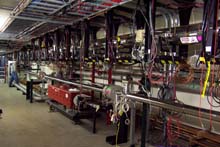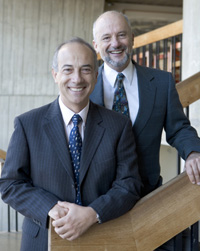 | Friday, November 11, 2005 |
|
Friday, November 11
Saturday, November 12 Monday, November 14
|
|
|
Secon Level 3 |
|
Friday, November 11 - Old Fashioned Ham & Bean - Black & Blue Cheese Burger - Summer Herb Cod - Stuffed Manicotti - Roasted Veggie & Provolone Panini - Assorted Pizza Slice - Vegetarian Stir Fry The Wilson Hall Cafe accepts Visa, Master Card, Discover and American Express at Cash Register #1. |
|
Wednesday, November 16
Thursday, November 17
Chez Leon Menu |
| Fermilab Today is online at: http://www.fnal.gov/today/ Send comments and suggestions to today@fnal.gov Hurricane Relief Page Fermilab Today archive Fermilab Today PDF Version Fermilab Result of the Week archive Fermilab Safety Tip of the Week archive Linear Collider News archive Fermilab Today classifieds Subscribe/Unsubscribe to |
| Crash Course in Luminosity, Key to Discovery at Fermilab
|
||
| This is the third story in a series that explains what luminosity is, and why we've recently gotten better at producing it in the Tevatron. | ||
|
||
|
Making the best antiproton beams The recipe for producing large numbers of collisions, or high luminosity, in the Tevatron seems rather simple: produce beams with a large number of protons and antiprotons; make sure that the beams are "nice and tight," and that few particles are lost as the beams pass through the chain of accelerators; send the beams into the Tevatron for final acceleration; and make the beams collide head-on at the center of the CDF and DZero detectors. Although there have been numerous improvements in the Fermilab accelerator complex during the past twelve months (and Fermilab Today will highlight several of them in this series), the flurry of luminosity records in the last six months is closely related to two success stories: the full integration of the Recycler storage ring into the antiproton supply chain, and the start-up of a new method to provide "nice and tight" antiproton beams via electron cooling. Located inside the Main Injector tunnel, the Recycler storage ring relies on hundreds of permanent magnets to steer antiprotons around a two-mile circle at a constant energy of 8 GeV (billion electron volts). After a rather slow startup, the commissioning of the Recycler has progressed rapidly in the last twelve months.
"In August 2003, the Recycler was basically on the ropes," said Cons Gattuso, the Recycler Deputy Department Head. "Now the machine can handle stashes of more than 3E12 antiprotons," or three million million antiprotons. The Recycler can store these antiprotons for hundreds of hours without significant losses, providing the desperately-needed relief for the 20-year-old Accumulator Ring of the Antiproton Source, which cannot handle so many antiprotons. (A second function of the Recycler, to recycle antiprotons at the end of a store, was dropped because the technical challenges outweighed the potential gains in luminosity.)
|
|
From Chicago Tribune, November 10, 2005 Astronomy: Light on a dark place Observatory aims to find the origin of cosmic rays Cosmic rays, the highest-energy particles in the universe, are being pitched at Earth from someplace beyond our galaxy, and for more than seven decades no one has been able to figure out where they are coming from. Now, armed with a cosmic ray catcher's mitt that is being inaugurated Thursday in Argentina on a site half the size of Rhode Island, scientists from the University of Chicago and Fermilab, along with more than 250 other scientists from 16 countries, hope to solve one of astronomy's biggest mysteries. In addition to searching for the source of cosmic rays, researchers will use the observatory, which consists of hundreds of small detectors spread over 1,200 square miles of ranch and farm land, to explore the universe in ways they couldn't before. The $50 million observatory is named after Pierre Auger, who in 1938 discovered particle showers on Earth caused by cosmic rays. He later studied cosmic rays at the University of Chicago using a hot-air balloon. Cosmic rays are so powerful that when they collide with air molecules in Earth's atmosphere they can temporarily produce energies similar to those that existed right after the Big Bang, the explosive beginning of the universe some 13 billion years ago.
"We want to understand how nature reaches these energies," said U. of C. astrophysicist Angela Olinto. "The energies of the particles that we'll be observing with this detector are millions of times more powerful than we can produce with particle accelerators on Earth. In principle these particles will give us the possibility of testing physics that we can't test in our laboratories. What happened at the beginning of the universe is the same that you could try to probe by reaching higher and higher energies."
|
| Petronzio Opens Dialogue Between GDE and FALC | ||
|
||
|
On Friday, 4 November, the Funding Agencies for the Linear Collider (FALC) met at Fermilab. At the meeting, representatives from funding agencies and governments around the world discussed the various issues involved with funding an International Linear Collider.
Read More
|
Education Office to Host Science-Based Reading Day |
|
Fermilab's Education Office will host a science-based Family Literacy Experience on Thursday, November 17. The program will be held in the Leon Lederman Science Education Center with sessions for children in preschool through eighth grade running from 3:30-7:15 p.m. The day is meant to mark the Illinois State Library Family Reading Day with a science twist as parents join their children in using hands-on, science program materials that integrate reading skills. "We know that literacy is more than just reading," said Susan Dahl, event coordinator and manager of teacher resources in the Education Office. "Research tells us that we need context to read effectively or our brains will discard the words we are reading." The hands-on activities used at the event, what Dahl calls "inquiry science activities," can be used to reinforce the information children read. Sessions will guide children through music and movement activities centered on the study of milk, construction of ball and ramp tests, exploration of the solid/liquid substance "Oobleck" and a simulation of work done by epidemiologists. Parents also will learn how to encourage their children to read by conducting similar activities at home.
The grade-appropriate sessions are as follows: preschool, 3:30-4:15 p.m.; grades K-2, 4:45-5:45 p.m.; grades 3-5 and grades 6-8, 6:15-7:15 p.m. Snacks will be available between sessions and prizes will be raffled off for both children and parents. The fee is $12 per child with adult companion. To register, or for more information, go to the Website.
|
|
Fermilab Lecture Series Fermilab Lecture Series Presents a World Year of Physics Lecture: "Einstein: A Man for the Millennium?" on December 2 at 8 p.m. The speaker will be Dr. John Stachel, Professor Emeritus of Physics, Director for Einstein Studies, Boston University.
Payday Change
Mileage Reimbursement Rate Increase
Top Turns Ten Videos
TC.J. Chenier & The Red Hot Louisiana Band
FSGI01 Will Be Decommissioned On Dec 31, 2005
New Classifieds on Fermilab Today |

